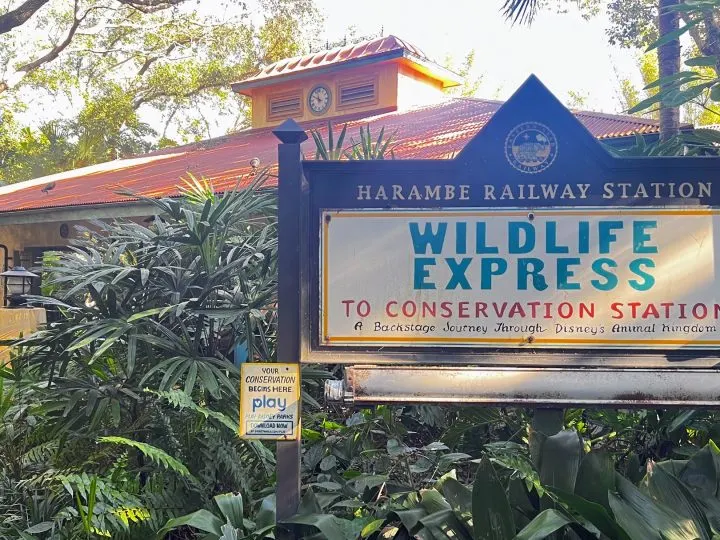When it comes to trains at Disney, usually, the Walt Disney World Railroad at Magic Kingdom is the first that springs to mind — but it’s not the only one on property. In fact, there’s also a train at Animal Kingdom, and it deserves a little applause, too.
Found in the Africa area of the park, the Wildlife Express Train is a fun little ride through backstage areas that you might not see otherwise, and it also takes you right to Rafiki’s Planet Watch, where you can find cool exhibits, a petting zoo, and more.
If you love animals and checking out Disney attractions that are off the beaten path, join us for our guide to Wildlife Express Train.
Wildlife Express Train Quick Facts
Description: Wildlife Express Train is a slow-moving train ride through the Africa area of the park, taking you through backstage areas to get a glimpse behind the curtain at the park.
Your train will stop at Rafiki’s Planet Watch, which offers several different animal exhibits, including a petting zoo, a short outdoor trail, and the Conservation Station, which will allow you to learn more about how animals are cared for at the park.
Location
Wildlife Express Train is located in the Asia section of the park, between Harambe Market and the Kilimanjaro Safaris area. You’ll pass the entry to the train station on your way to the Gorilla Falls Exploration Trail.
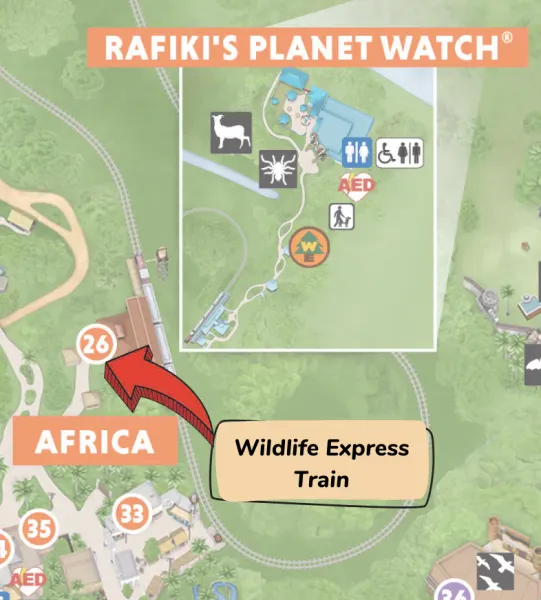
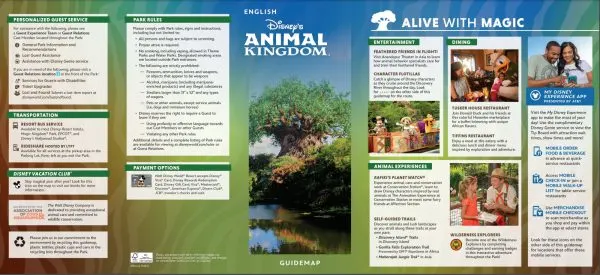
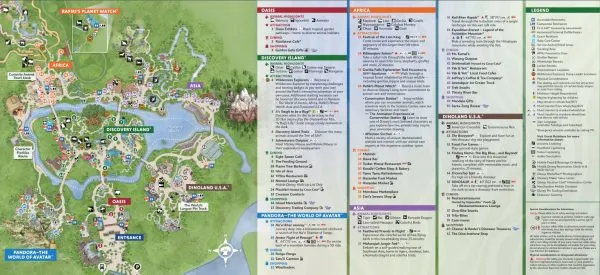
How to Ride Wildlife Express Train
Wildlife Express Train has a Standby Line only — there is no Lightning Lane or Single Rider Line offered here.
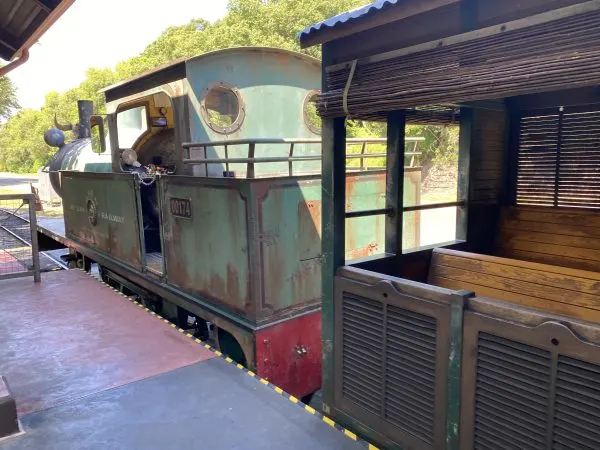
Though sometimes the standby area can get a little backed up while people wait for the next train to come into the station, there typically isn’t a long wait, though you may notice that it’s busiest in the middle of the day (like most attractions).
Trains come by every 5-7 minutes, and that’s usually the longest you should expect to wait; it’s rare that anyone waiting at the time wouldn’t be able to board.
Do I Need To Use Genie+ at Wildlife Express Train?
Genie+ isn’t offered at Wildlife Express Train, but that’s totally fine — due to the train’s high capacity and the fact that this isn’t a super popular attraction at Animal Kingdom, there is almost never a wait.
You likely won’t wait any longer than 10 minutes to ride, even if you happened to get in line just as a train was pulling out of the station without you.
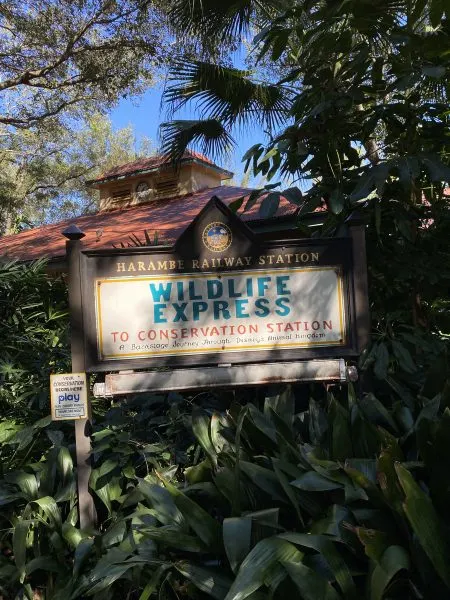
There are a lot of other attractions at this park that are worth using Genie+ if you choose to purchase it, so be sure to check out our touring strategies for Animal Kingdom for more advice on which Lightning Lanes to book during your visit.
Rider Switch/Child Swap
Since Wildlife Express Train doesn’t have a height requirement, Rider Switch isn’t offered here.
The good news: Kids of all ages, including babies, should be comfortable on this slow-moving, very laid back ride.
What to Expect When You Ride
Queue
It probably won’t surprise you to find out that the queue at Wildlife Express Train actually looks a lot like a train station. When you enter the Harambe station, which is consistent with the Africa theming, you’ll be able to hang out until it’s time to board the next train while under a covered waiting area.
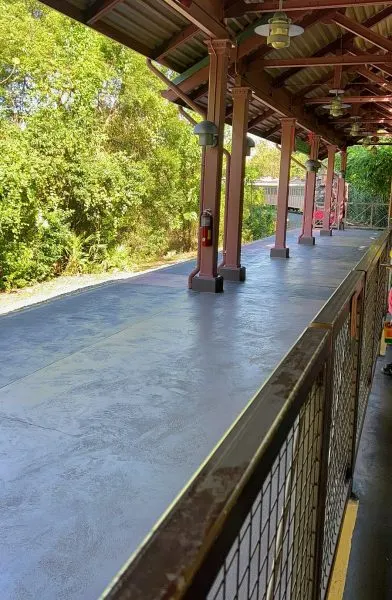
When you take the train back — which is the only way to return to the rest of Animal Kingdom from Rafiki’s Planet Watch — you’ll wait in a similar covered train station that includes fans and even benches. This train station is colorful and includes posters of different Disney Nature documentaries, with animal theming everywhere.
Ride Vehicles
The ride vehicles here are — what else? — train cars, but different from the kind you’d sit on when aboard the Walt Disney World Railroad. Here, the seats are actually benches, and you’ll sit sideways so you can take in all the sights during your trip.
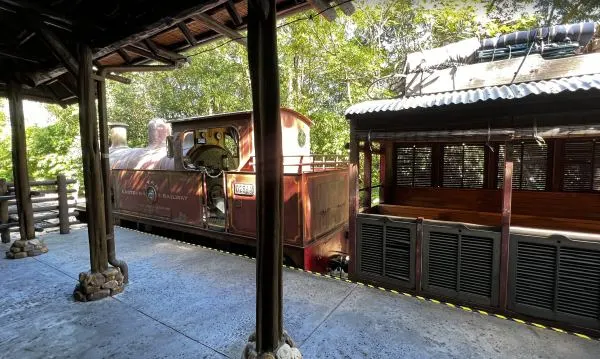
Three steam locomotives run on this line, and each have a capacity of 250 passengers. There are two rows of benches per car.
Accessibility Information
Guests using wheelchairs and ECVs may remain in them for this attraction. When you arrive at the queue for Wildlife Express Train, a Cast Member will direct you to a special waiting area where you will be able to board.

There is space available for one wheelchair or ECV per train car, so you may have to wait a bit longer to board if it happens to be particularly busy.
Handheld captioning and assistive listening are available for guests with hearing disabilities.
Motion Sickness
Though this is a slow-moving attraction, some people may feel motion sickness from riding sideways on the train and may choose to skip this one.
For more advice, check out our tips on rides that may cause motion sickness at Disney.
On the Ride
Once you board the train in Africa, you’ll pass through some lush greenery and get a peek at the loading area of Kilimanjaro Safaris from a bit of a different view. As you ride, a Cast Member will explain what you’re looking at, so don’t worry if you can’t tell right away!
After you pass the safari area, your train will pass an area where animals are kept at night or when they need extra care. You’ll see Tembo House, where the elephants are kept, before pulling into the station.
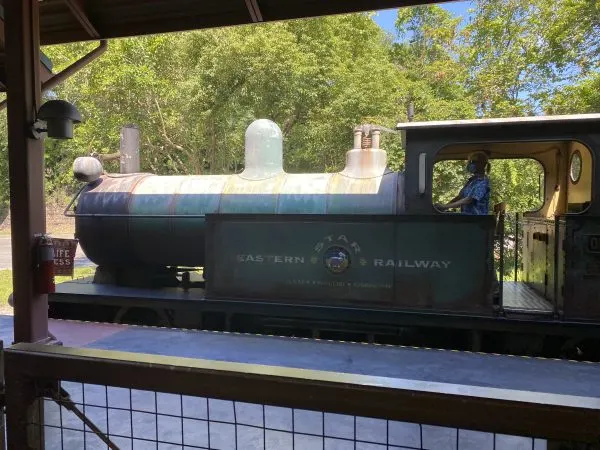
Here, you will be able to get off and enjoy the attractions at Rafiki’s Planet Watch, or you can stay on board and ride back to Africa.
The train ride is about seven minutes long each way, but budget for more time if you’re taking a round trip since you will have to wait for people to get on and off at the station.
Is Wildlife Express Train Kid-Friendly?
Wildlife Express Train is one of the most kid-friendly attractions at Animal Kingdom, and little ones will likely enjoy the destination, too, since petting zoos and the opportunity to see animals up close are usually a hit with all ages.
There isn’t anything here that should scare young children, but while planning your trip, be sure to check out our guides to things kids might find scary at Disney World.
Strollers
Strollers will need to be parked at the Harambe station before boarding the train.
Be sure to bring anything valuable with you on the train, like phones, wallets, and keys, and you may want to cover up your stroller before leaving it behind in case an unexpected rain storm hits while you’re gone.
Keep in mind that between the train ride there and back and exploring Rafiki’s Planet Watch, you may be gone for awhile, so you might want to bring a diaper bag along with you if you are traveling with babies or toddlers.
History
The Wildlife Express Train opened when Animal Kingdom did on April 22, 1998. It was modeled after the historic Indian Peninsula Railroad, and the train itself was built in the United Kingdom by Severn Lamb before being shipped over to Orlando.
The trains are meant to evoke memories of British railroads in the early 1900s and were weathered by Disney Imagineers so they would look like they’d stood the test of time as if they had transported people across the African savanna for decades.
Other Fun Details
- The trains were built just a few miles from William Shakespeare’s home in Stratford-upon-Avon.
- The first engine is named R. Baba Harpoor as a tribute to Imagineer Bob Harpur.
- The trains belong to the fictional Eastern Star Railway, which can also be spotted on a board at the Walt Disney World Railroad at Magic Kingdom.
Other Attractions in Africa
- Gorilla Falls Exploration Trail
- Festival of the Lion King
- Wildlife Express Train (takes you to Rafiki’s Planet Watch)





